Maine is a US state found in the northeastern part of the country. Many people know it well for being a regular plot for horror novels authored by Stephen King. This state boasts several climatic conditions, meaning that it experiences cold winters and hot summers. Additionally, it has 32 distinct state parks and 4 different national parks. For this reason, this state offers lots of excellent locations for birding. One of the common birds in the state is the owls, especially the Northern Saw-Whet Owl species. Today, we’ll be discussing the different species of owls in Maine. We shall also give you tips on where and when to find these birds in the state.
Now, let’s discuss each owl species in detail.

1. Great Horned Owl
Scientific name: Bubo virginianus
Weight: 32.1-88.2 oz
Length: 18.1-24.8 inch
Wingspan: 39.8-57.1 inch
Great Horned Owls are perhaps the most popular and vast spread owls in Maine and North America at large. That’s because they reside in Maine and across the rest of the United States all year round.
They have an orange face with contrasting lines of black and white like in a tiger. You’ll find their undersides with horizontal bars that tend to resemble tree branches when observed from the ground.
When you look from above, you’ll notice these owls looking like mottles of tree sheds. This helps these owls to hide from their predators or launch an attack on their prey.
As the name suggests, these owls have long and pointed-looking ears that look like horns. They also have thick and stocky yet medium-sized bodies.
For easy identification, the Great Horned owls often have round yellow eyes that make them look distinct. Plus, they often produce a loud hoot, especially the females, that is easy to identify.
If you want to spot these owls, be sure to look ions with denser woodlands. Alternatively, consider checking them in suburban areas like parks, the city where they like to breed and nest successfully.
What’s more, they can still survive in desert fringes, tundra, swamps, prairies, and urban areas. In Maine, you can find these raptors nearly everywhere in the state, starting from the Arctic south to the tropics.
After forming a breeding pair, the individuals will protect the nest as both sexes are quite territorial. Besides, these breeding pairs often last longer and will try to stay in their territory even after breeding. But, when it comes to roosting, these owls will do so separately.
This owl species is aggressive and very strong. Therefore, they tend to prey on larger animals to sustain their relatively huge bodies. They eat geese, rabbits, groundhogs, numerous bird species, and other owls.
Additionally, you’ll find these owls eating small prey like insects, scorpions, invertebrates, reptiles, frogs, and mice. The Great Horned Owl has a special diet that’s located in the habitat they live.
They also attack and feed on skunks. That’s why you’ll often find them along with their pellets and nests smelling skunks.
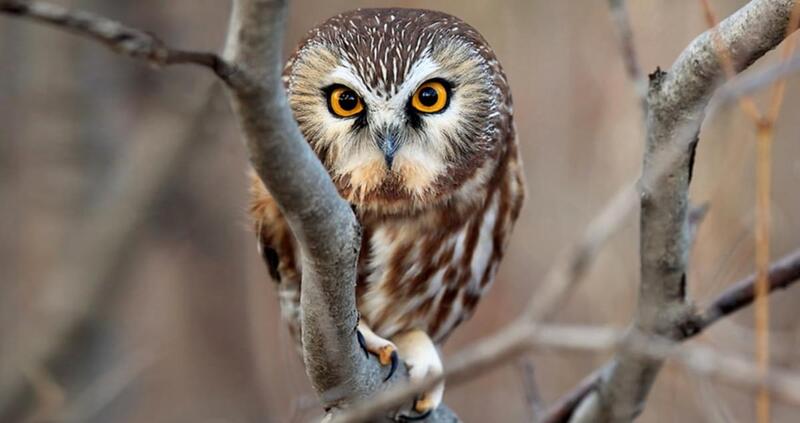
2. Northern Saw-Whet Owls
Scientific Name: Aegolius acadicus
Weight: 2.3-5.3 oz
Length: 7.1-8.3 inch
Wingspan: 16.5-18.9 inch
These owls are permanent residents of Maine. This means that you can find them all year round living in the conifer groves and Maine forests. They are small, robin-sized, and have large yet round heads and huge orange eyes.
Other than their small size, these owls are pretty hard to locate. You’ll find them with mottled brown plumage that easily matches with the trees around them. And have their bellies covered in bright white feathers.
They’re also very secretive and prefer laying low and avoid being spotted. Like many other owls, the North Saw-Whet owls are active during the night.
When it comes to nesting, these owl species are very selective. That’s why they tend to nest only in dense woodland areas and reside in mature forests as they can.
Although most males are monogamous, some often mate during periods of food abundance. Seemingly, that’s only the thing that affects the monogamous state of this owl species.
The breeding pairs formed never last long, and most of the owls will opt to look for new mates in the following breeding seasons. With their small sizes, these owls usually get preyed on by various larger owl species like the Great Horned Owl and more.
As for dieting, these owls feed on deer mice, shrews, and voles. They also supplement their diet with insects, invertebrates, and small birds if necessary.
Their range constitutes most parts of the US and southern Canada. But, some members are migratory and often moves to the south during winter while the rest reside in one place the whole year.
Want to spot these owls in Maine? Well, look them out in mixed hardwood and dense coniferous forests with nearing rivers. Also, listen to their hooting sounds that look like a saw’s sharpening (whetting), hence their name.
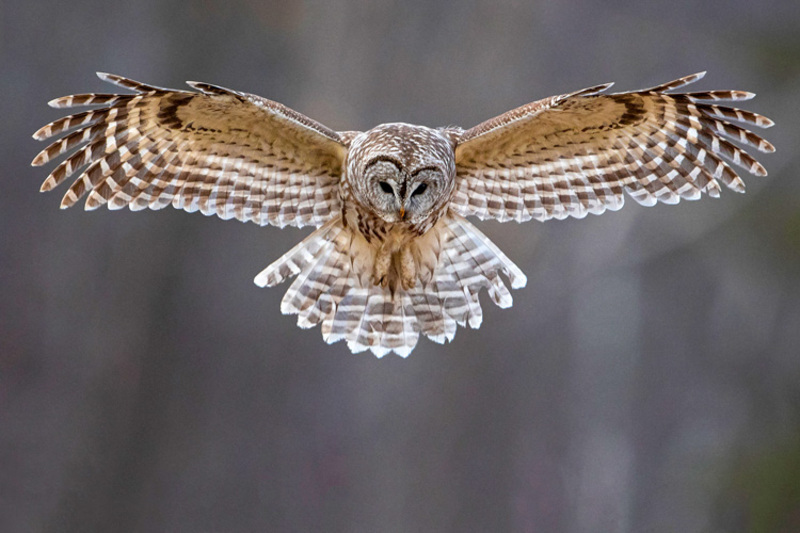
3. Barred Owl
Scientific name: Strix varia
Weight: 16.6-37.0 oz
Length: 16.9-19.7 inch
Wingspan: 39.0-43.3 inch
This owl species in Maine has a plumage of brown and white bars on the wings made by feathers. That’s where this owl gets a name at the same time, helps it camouflage in the trees.
Also known as Hoot Owl, this species is an unthreatened nocturnal owl species living in Western and southeastern Canada. You can also find them in the entire Prairie Provinces, Northwest Pacific, and all over the eastern United States.
Thus, they’re common in Maine, and you can spot them mainly in the woods closer to swamps and marshlands. These non-migratory owls are also found in various mixed woodland areas.
One unique thing about these owls is that they are very inquisitive and curious. And most of the time, they’ll watch as you pass by. If they get nervous on approach, these owls fly off to another tree to continue perching.
Like many owl species, these owls hunt during the night and roost the whole day. They depend on mice and small rodents for food but generally eat anything meaty. These owls will readily feed on squirrels, moles, bats, rabbits, weasels, different birds, snakes, frogs, juicy insects, and many more.
Their breeding pairs are long-lasting and will protect their territory from foreigners. When it comes to hooting, these owls have classical sounds like those featured in scary movies and Halloween tales. Be sure to listen to say, “who cooks for you?” usually during the day.
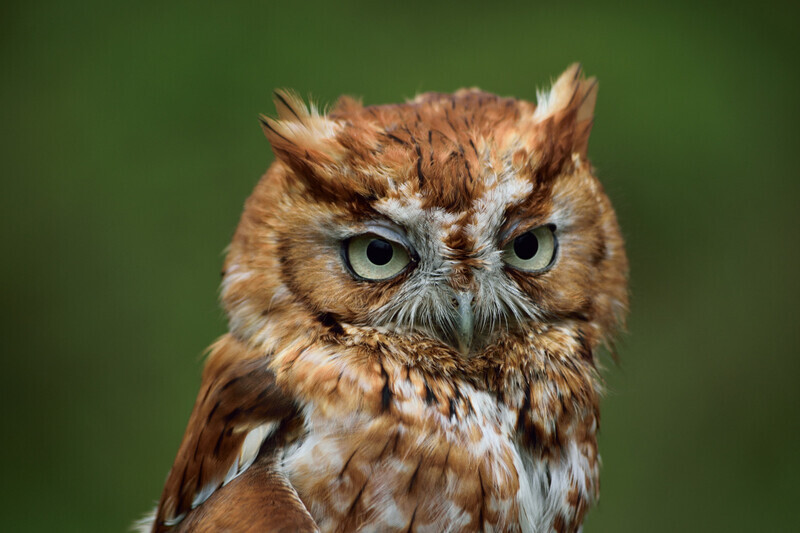
4. Eastern Screech-Owl
Scientific name: Megascops asio
Weight: 4.2-8.6 oz
Length: 6.3-9.8 inch
Wingspan: 18-24 inch
Screech-owls are a perfect reminder of professional wrestlers thanks to their short, stocky, and absence of necks. They can have either a red or grey plumage, with most members being red.
These owls boast fake ear tufts on the sides of their heads, underneath the feathers, and parallel to their eyes. The clumps can easily camouflage to break their silhouette, though they are movable to pass information with other members.
You’ll find them residing in nearly wooded regions of the eastern Rockies. This range starts from the Gulf of Mexico in the north and ends in the Canadian border.
They are permanent residents and exist in most areas; hence, they are among the most common owls in Maine. While in their range, you can easily hear them at night making various calls, hoots, and songs. They produce an evenly pitched trill known as tremolo for making contact with one another.
However, these owls tend to avoid crowded spots with other larger owls, especially the Great Horned Owl. And they don’t fear humans much as they can rest comfortably on top of streetlamps, inside populated properties, and next to highways or roadways.
But, they prefer living in densely forested areas. The members are quite opportunistic and feed primarily on lizards, insects, rats, mice, earthworms, tadpoles, and other small bird species.
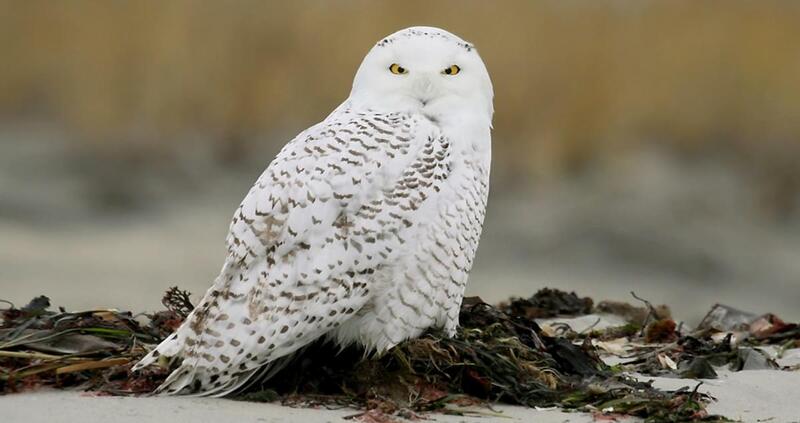
5. Snowy Owl
Scientific name: Bubo scandiacus
Weight: 56.4-104.1 oz
Length: 20.5-27.9 inch
Wingspan: 49.6-57.1 inch
This is yet another most common owl species you can find in the state of Maine during the winter seasons. They are large-sized birds with white plumage that enables them to camouflage in the snow. But, you’ll find them with horizontal dark stripes all over their bodies except the face and breast.
These migratory owls often change the environs in different seasons. For instance, you’ll find them in northern Canada when they mate during the summer. When winter kicks in, these owls move to the south.
For this reason, these birds only appear further in the northern US. But sometimes, a large flock of Snowy Owls and other birds often migrate towards the south.
Ptarmigan and lemmings found on the tundra form most of their summertime food. As for winters, these owls’ diet becomes more varied. They’ll look for ducks, squirrels, seabirds, rodents, and rabbits to prey on.
Being well-adapted to their habitats, Snowy Owls are good prey detectors even from far. Other than that, you’ll hear these owls make loud “hoo-hoo” sounds when looking for a mate or protecting their territory.

6. Great Gray Owl
Scientific name: Strix nebulosa
Weight: 24.7-60.0 oz
Length: 24.0-33.1 inch
Wingspan: 53.9-60.2 inch
The Great Gray Owls stand out as one of the largest and tallest owl species known to exist. As per their name, these birds are usually silvery-grey colored though they can vary in plumage, including brown feathers. They also have alternating dark and light stripes, making them more easily identifiable.
You’ll probably spot some of these owls in meadow regions where they mainly hunt. And their range often extends from Alaska, cutting across to the southern edge of the Hudson’s Bay up to northern Ontario.
These owls cover a larger territory in their ranges though they like living in forests nearer a clearing spot. These owls often hunt during the daytime when having nestlings or in winters when food becomes scarce.
Their diets may vary depending on their habitats, mainly voles, ducks, quail, small hawks, and assorted songbirds. The males are monogamous and form long-lasting breeding pairs. Yet, they don’t stay closer to one another non-breeding months.
They boast a quite distinctive, deep, and bold call that sounds “whoooo, woo, woo, woo.” Additionally, these owls have soft double hoots used when feeding their offspring and protecting their territories.
Great Gray Owls are lazy to build their nests. Instead, they use nests made by other large birds. Once they secure a used nest, these birds will protect it with utmost courage.
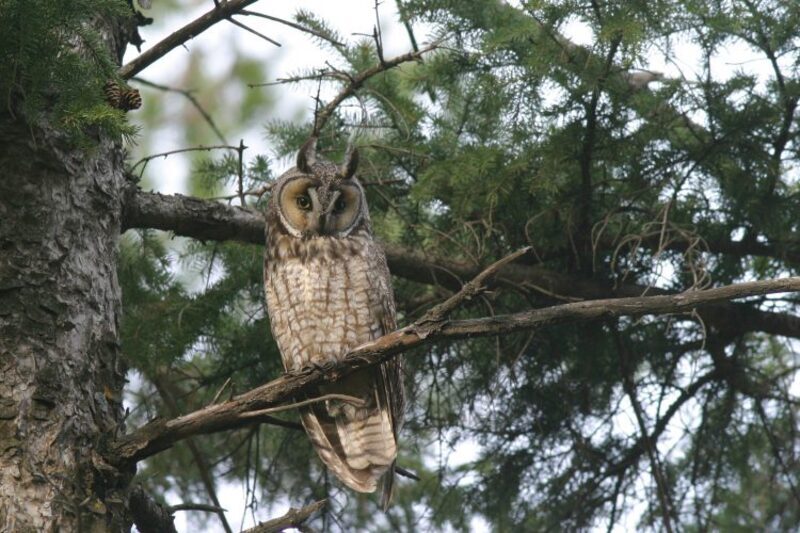
7. Long-Eared Owl
Scientific name: Asio otus
Weight: 7.8-15.3 oz
Length: 13.5-15.8 inch
Wingspan: 35.4-39.4 inch
This owl species is more famous with long and feathery ear tufts on their heads, hence the name. Their bodies are covered in black and brown feathers, while the faces being orange in color and seem surprised.
These owls prefer roosting in dense woodlands when breeding. Combining this with their remarkable camouflaging abilities, these owls are tough to spot.
During other periods, these birds roost to lose colonies of about 100 members. And in each breeding season, these colonies tend to nest near one another though they won’t roost together.
These owls’ range comprises nearly all North America region just below the Hudson’s Bay to Mexico. You’ll readily find these owls infringe on mixed forests that give easy access to open spaces for hunting. Typically, they use woodlands and groves of conifers as nesting spots.
When it comes to dieting, these birds primarily eat voles and small rodents they hunt in the open grasslands. In times of food shortage, they’ll eat small species of birds.
Because the Long-Eared Owls are harder to spot, the best way to know they’re around is to listen. They are usually talkative during mating periods. You’ll hear them repeat their typical call between 10 to 100 times, and it sounds like a low-pitched “hoo” that is uniformly spread after every few seconds.
Amongst all other owl species, these raptors are a bit unique as they’re sociable. They live in clusters and often share the same roost.
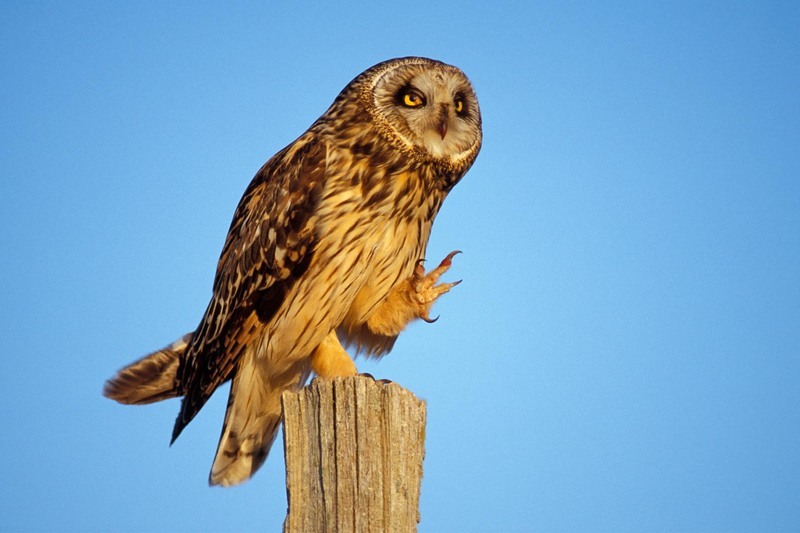
8. Short-Eared Owl
Scientific name: Asio flammeus
Weight: 7.3-16.8 oz
Length: 13-17 inch
Wingspan: 33.5-40.5 inch
This owl species in Maine features tiny and short ear tufts that are hardly visible, thus the name Short-eared owl. They are medium-sized and covered in brown feathers that are easy to spot with a buff that plumages the entire body.
The Short-eared Owls are found in large open grasslands, airports, and meadows. That’s when you can easily spot them at dusk. Their range is in most parts of Northern America and also exists in Mexico.
However, their activities may vary depending on the season. For instance, they are always active all day and night during breeding periods. These birds migrate to the north to breed during warmer months.
You’ll find the females spending most of their daytime performing courting displays. But, they’ll hunt during the night. Once they mate, the males do very little to raise their young ones. Instead, they will protect the female while she sits in the nests during incubation.
These owls’ most favorite food consists of voles, and they’ll spend hunting for these meals all day. Besides that, they feed on small songbirds, seabirds, and rodents. Primarily, these birds are not vocal. However, they have an oddly enough call that sounds awful.

9. Boreal Owl
Scientific name: Aegolius funereus
Weight: 3.2-7 oz
Length: 9.0-10.5 inch
Wingspan: 20-24 inches
The Boreal Owl is one of the smallest owl species in Maine. You’ll find it in various patterns and colors that range from reddish-brown to gray. They may have dots or streaks on either the upper or lower sides of their bodies.
Basically, these owls’ range extends from Alaska to Canada. They are massively found in Canada’s large boreal forests, where you can spot them in stands of spruce, fir, birch, and aspen trees.
Due to their remote sites, these birds are pretty not common, hence challenging to study and even see them. These owls like perching low in alpine areas and coniferous forests where they move their heads back and forth to listen to the sounds the preys make.
Their remarkable hearing abilities enable these owls to hunt with ease. Bats, voles, small birds, beetles, frogs, and young squirrels form a primary food source for these owls.
The Boreal Owls have a distinct call that consists of small sequences of hooted whistles that become progressively louder. Males often hoot to call and attract the females during breeding periods.
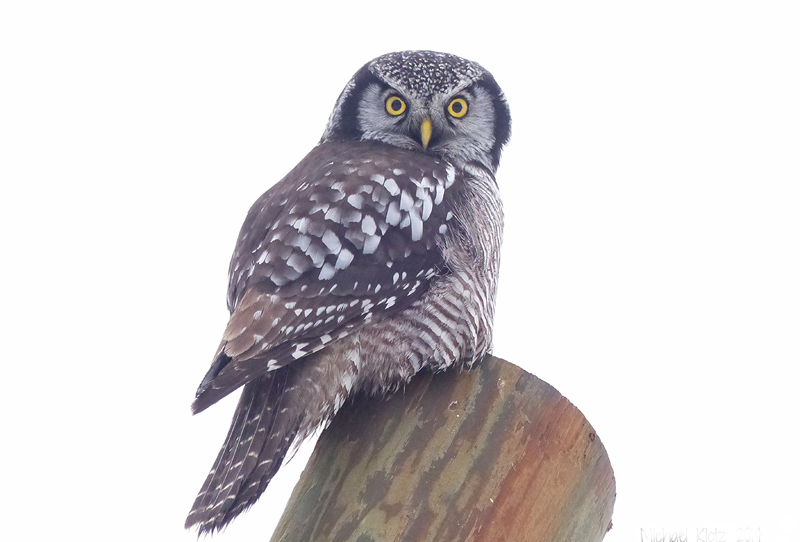
10. Northern Hawk Owl
Scientific name: Surnia ulula
Weight: 11-12 oz
Length: 14.2-17.75 inch
Wingspan: 31-35 inch
As the name depicts, these owls act and behave like hawks. They have uncommon traits to owls that include; sitting solitary in tall and dense trees and hunting during the night.
These raptors have light-colored bellies that are not easily visible while flying high in the sky. But, their prominent dark brown plumage with lighter speckles at their back make them unnoticeable when seated in the trees.
The Northern Hawk Owls are typically Canadian and tend to love the northern climates and boreal forest. However, when there’s scarcity in preys, these owls move southwards into the US.
Generally, these owls like residing in open spaces of the coniferous forests. They’re also present in mixed forests with pine trees, including birch, larch, willow, or interspersed trees.
The males produce a low-rolling “hoo-hoo-hoo-hoo” sound which they repeat about 10 to 200 times. As for the females, they have the same call but hoarser and shorter.
When it comes to dieting, the Northern Hawk Owls love feeding on voles. That’s because the voles can be fed as a whole and are usually in plenty. Alternatively, these birds prey on mice, lemmings, red squirrels, young hares, and rats. They also eat smaller songbirds such as jays, finches, grackles, sparrows, starlings, and robins.
Related
- Ever wondered why owls hoot at night? It’s not necessarily to be scary! Check out what we found out in: Why Do Owls Hoot At Night?
- Owls have beaks tailored specifically towards their style of hunting. Bird beaks have evolved over thousands of years to help their wearers feed, hunt, and get by in their day to day activities. Check out this article to learn more about how bird beaks have evolved over time.
Leave a Reply